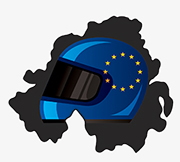 On the 2nd December the European Commission hosted a conference on the results of the public consultation preceding the drafting of the European Road Safety Action Programme 2011-2020.
On the 2nd December the European Commission hosted a conference on the results of the public consultation preceding the drafting of the European Road Safety Action Programme 2011-2020.
Most worrying is that they state in the context of failed solutions to reduce casualties, “Discouraging or restricting the use of PTWs may be more acceptable.” and “A further reduction in number of PTW accidents is only possible with a very restrictive licensing system with access only at higher age limits, more extensive training and testing, lower power to weight ratios or restricted top speed.”
More than 400 stakeholders with different backgrounds, including motorcycle representatives discussed the issues of road safety in the European Union and regarding motorcycles, focused on the safety of motorcycles and on how to adjust infrastructure to different categories of road users.
The Commissioner for Transport Antonio Tajani opening speech recognised motorcyclists as vulnerable road users along with pedestrians, cyclists and elderly people.
He stated that, “’The public consultation and today’s conference contribute to defining a clear and measurable European action programme on road safety for the period 2011-2020. Europe cannot be lax on road safety – tens of thousands of human lives are at stake each year. This action programme will help us remain demanding and determined in our fight against road accidents.”
However while recognising that motorcyclists are vulnerable road users, a new section on the European Commission’s website – EUROPA – dedicated to road safety, brands motorcycles as dangerous.
“Motorcycles and mopeds are the most dangerous mode of transport in the EU.”
“Riding a PTW (Powered Two Wheeler) is also much more dangerous than using another motor vehicle.”
Right To Ride says, “When did a mode of transport become dangerous? A food blender, a set of ladders or a lawn mower can be dangerous if it’s not used properly. If we are to brand the most “dangerous” road user, it is effectively the car driver who is mainly responsible for the carnage of motorcyclists.”
While recognising that studies of moped and motorcycle accidents find large proportions of collisions with a car driver, who should have waited for the motorcyclists, indicating problems with the perception of motorcycles, the Commission trots out the same solutions of headlights and reflective clothing, not that drivers should be taught at an early stage in their training to look, see and recognise motorcyclists.”
The solution is not their recommendation that (Electric) power assisted pedal bikes and tilting three wheelers could become acceptable alternatives in the near future for some existing groups of PTW users.
Right To Ride calls on the European Commission on Road Safety, as well as the European motorcycle user groups and European Motorcycle Industry, being the supposedly influential bodies and finally, our politicians as “European Citizen” representatives to delete the branding of motorcycles as dangerous on the EUROPA website and that responsible motorcycle, scooter and moped use should be encouraged as a solution for congestion and placed in a hierarchy of viable “green” alternatives to car use.
Links
http://ec.europa.eu/transport/road_safety/specialist/knowledge/poweredtwowheelers/index.htm
http://ec.europa.eu/transport/road_safety/users/motorcyclists-mopdeds/index_en.htm
Powered Two Wheelers – Web text of the European Road Safety Observatory – Source of Dangerous Motorcycles position 2006 written without input from motorcycle user groups. http://ec.europa.eu/transport/road_safety/specialist/knowledge/pdf/powered_two_wheelers.pdf 289kb
Motorcycle Madness From the EC
7th December 2009
 Original article available by Clicking Here
Original article available by Clicking Here
On the European Commission’s Europa website, as part of the “solution” to reduce road casualties they want to “discourage or restrict” the use of motorcycles.
Accident prevention and injury protection
There are a number of measures that can make riding a PTW safer.
These can focus on reducing the number of accidents occurring or improving injury protection when accidents do occur.
However, even if these measures were used to their full potential, the accident rates of PTW’s will still be much higher than for driving a car. A further reduction in number of PTW accidents is only possible with a very restrictive licensing system with access only at higher age limits, more extensive training and testing, lower power to weight ratios or restricted top speed.
These measures will not be popular with present user groups or the PTW industry. Discouraging or restricting the use of PTW’s may be more acceptable if alternatives are made more attractive.
Pedal bike, public transport or cars do not seem to be alternatives to the present use of PTW’s. (Electric) power assisted pedal bikes and tilting three wheelers could become acceptable alternatives in the near future for some existing groups of PTW users.
HJ asks, “How, exactly, is a ’tilting three wheeler’ safer than a motorcycle? I’d really like to know. And if we are all supposed to be concerned either about climate change or diminishing world resources or both then surely motorcycles benefit the world far better than cars.”
Also on the EU Commission’s website is the statement “Motorcycles and mopeds are the most dangerous mode of transport in the EU”.
Why are we paying these EC lunatics huge amounts of money to ruin our lives?



Speak Your Mind